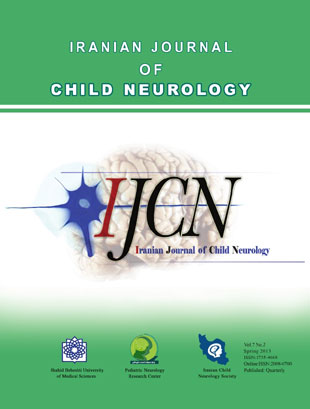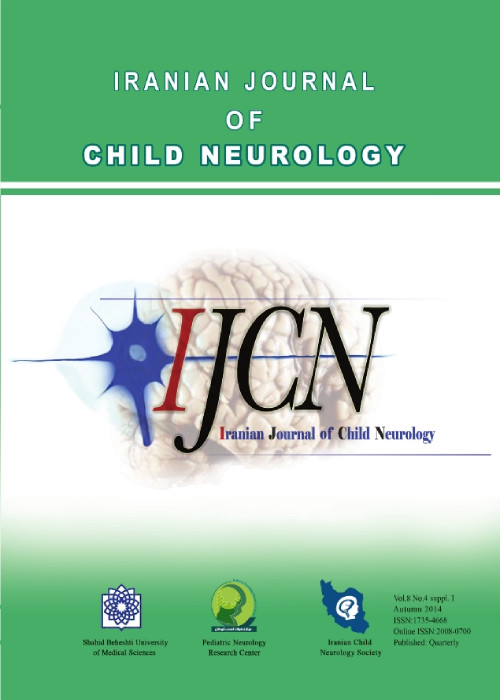فهرست مطالب

Iranian Journal of Child Neurology (IJCN)
Volume:7 Issue: 2, Spring 2013
- تاریخ انتشار: 1392/02/25
- تعداد عناوین: 9
-
-
Pages 1-10How to Cite This Article: Inaloo S, Haghbin S. Multiple Sclerosis in Children. Iran J Child Neurol. 2013 Spring;7(2):1-10.Multiple sclerosis (MS) is the most important immune-mediated demyelinated disease of human which is typically the disease of young adults. A total of 4% to 5% of MS population are pediatric. Pediatric MS is defined as the appearance of MS before the age of sixteen. About 80% of the pediatric cases and nearly all adolescent onset patients present with attacks typical to adult MS. Approximately 97% to 99% of the affected children have relapsing-remitting MS, while 85% to 95% of the adults experience such condition. MS in children is associated with more frequent and severe relapses. Treatment is the same as adults. We aimed to review the epidemiology, etiology, clinical manifestations, and treatment of MS in children.
-
Pages 11-16ObjectiveLumbar puncture (LP) essentially is a painful and stressful procedure that indicated for diagnosis and therapeutic purposes. One way to reduce the anxiety is to administer an oral premedication. The aim of this study is to compare clinical effects of oral midazolam and oral promethazine in LP.Materials and MethodsThis prospective randomized controlled clinical trial study wasperformed on 80 children aged 2-7 years that were candidate for LP. They were divided into two randomized equal groups. First group received oral midazolam syrup 0.5 mg/kg and the other group received oral promethazine syrup 1mg/kg. Level of sedation, hemodynamic changes and any other complications were monitored every 5 minutes from 30 minutes before the start of the procedure.ResultsMidazolam group and promethazine group were similar in age, gender and weight. Midazolam had significantly shorter onset of sedation and also shorter duration to maximal sedation. The two groups were similar with respect to sedative effect at all time. The only complication that was significantly more in midazolam group was nausea and vomiting.ConclusionMidazolam syrup and promethazine syrup have same sedative effect in children. Both of these medications are easy to use in preschool children and none of them appeared to be superior to another.
-
Pages 17-21ObjectiveMuscle biopsy is a very important diagnostic test in the investigation of a child with suspected neuromuscular disorder. The goal of this study was to review and evaluate pediatric muscle biopsies during a 2-year period with focus on histopathology diagnosis and correlations with other paraclinicstudies.Materials and MethodsWe investigated 100 muscle biopsies belonging to patients with clinical impression of neuromuscular disorder. These patients have been visited consecutively by pediatric neurologists during 2010 to 2012. Samples were investigated by standard enzyme histochemical and immunohistochemical techniques.ResultSixty-nine (69%) males and 39 (39%) females with a mean age of 5.7 years were evaluated. Major pathologic diagnoses were Muscular dystrophy (48 cases), Neurogenic atrophy (18 cases), nonspecific myopathic atrophy (12cases), congenital myopathy (6 cases), storage myopathies (4 cases) and in 6 cases there was no specific histochemical pathologic finding. EMG was abnormal in 79 cases. Degree of correlation between EMG and biopsy result was significant in children ≥ 2 years of age.ConclusionThis study confirms the high diagnostic yields of muscle biopsyespecially only if standard and new techniques such as enzyme study and immunohistochemistry are implemented. Also, we report 11 cases of Merosin negative congenital muscular dystrophy. This is the largest documented case series of Merosin deficient congenital muscular dystrophy reported from Iran.Keywords: Muscle biopsy, Congenital myopathy, Muscular dystrophy, Merosin, EMG
-
Pages 23-30ObjectiveAutosomal recessive primary microcephaly (MCPH) is a neurodevelopmental and genetically heterogeneous disorder with decreased head circumference due to the abnormality in fetal brain growth. To date, nine loci and nine genes responsible for the situation have been identified. Mutations in the ASPM gene (MCPH5) is the most common cause of MCPH. The ASPM gene with 28 exons is essential for normal mitotic spindle function in embryonic neuroblasts.Materials and MethodsWe have ascertained twenty-two consanguineous families withintellectual disability and different ethnic backgrounds from Iran. Ten out of twenty-two families showed primary microcephaly in clinical examination. We investigated MCPH5 locus using homozygosity mapping by microsatellite marker.ResultSequence analysis of exon 8 revealed a deletion of nucleotide (T) in donor site of splicing site of ASPM in one family. The remaining nine families were not linked to any of the known loci. More investigation will be needed to detect the causative defect in these families.Conlusion: We detected a novel mutation in the donor splicing site of exon 8 of the ASPM gene. This deletion mutation can alter the ASPM transcript leading to functional impairment of the gene product.
-
Pages 31-36ObjectiveDravet syndrome or severe myoclonic epilepsy of infancy (SMEI) is a baleful epileptic encephalopathy that begins in the first year of life. This syndrome specified by febrile seizures followed by intractable epilepsy, disturbed psychomotor development, and ataxia. Clinical similarities between Dravet syndrome and generalized epilepsy with febrile seizure plus (GEFS+) includes occurrence of febrile seizures and joint molecular genetic etiology. Shared features of these two diseases support the idea that these two disorders represent a severity spectrum of the same illness. Nowadays, more than 60 heterozygous pattern SCN1A mutations, which many are de novo mutations, have been detected in Dravet syndrome.Materials and MethodsFrom May 2008 to August 2012, 35 patients who referred to Pediatric Neurology Clinic of Mofid Children Hospital in Tehran were enrolled in this study. Entrance criterion of this study was having equal or more than four criteria for Dravet syndrome. We compared clinical features and genetic findings of the patients diagnosed as Dravet syndrome or GEFS+.Results35 patients (15 girls and 20 boys) underwent genetic testing. Mean age of them was 7.7 years (a range of 13 months to 15 years). Three criteria that were best evident in SCN1A mutation positive patients are as follows: Normal development before the onset of seizures, onset of seizure before age of one year, and psychomotor retardation after onset of seizures.Our genetic testing showed that 1 of 3 (33.3%) patients with clinical Dravet syndrome and 3 of 20 (15%) patients that diagnosed as GEFS+, had SCN1A mutation.ConclusionIn this study, normal development before seizure onset, seizures beginning before age of one year and psychomotor retardation after age of two years are the most significant criteria in SCN1A mutation positive patients.Keywords: Dravet syndrome, GEFS+, SCN1A mutations
-
Pages 37-42ObjectiveApproximately one third of epileptic children do not achieve complete seizure improvement. Zonisamide is a new antiepileptic drug which is effective as adjunctive therapy in treatment of intractable partial seizures.The purpose of the current study was to evaluate the effectiveness, safety, and tolerability of Zonisamide in epileptic children.Materials and MethodsFrom November 2011 until October 2012, 68 children who referred to Children’s Medical Center and Mofid Children Hospital due to refractory epilepsy (failure of seizure control with the use of two or more anticonvulsant drugs) entered the study. The patients were treated with Zonisamide by dose of 2- 12 mg/kg daily in addition to the previous medication. We followed the children every three to four-weeks intervals based on daily frequency, severity and duration of seizures. During the follow-up equal and more than fifty percent reduction in seizurefrequency or severity known as response to the drug.ResultsIn this study 68 patients were examined that 61 children reached the last stage.35 (57.4%) were male and 26 (42.6%) patients were female.After first and six months of Zonisamide administration daily seizure frequency decreased to 2.95±3.54 and 3.73±3.5 respectively. There was significant difference between seizure frequency in first and six month after Zonisamide toward initial attacks. After six months ZNS therapy a little side effects were created in 10 patients (16.4%) including stuttering(4.9%), decreased appetite (4.9%), hallucination (1.6%), dizziness(1.6%), blurred vision(1.6%) and suspiring(1.6%) as all of them eliminated later dosage reduction.ConclusionThis study confirms the short term efficacy and safety of Zonisamide in children with refractory epilepsies.Keywords: Intractable Epilepsy, Antiepileptic drugs, Zonisamide
-
Pages 43-46Joubert syndrome is a very rare disorder characterized by respiratory irregularities, nystagmus, hypotonia, and global developmental delay with abnormalities of cerebellum. We present two cases of this syndrome with different phenotypes. The first case was an 8-month-old girl with hypotonia, apnea, and mild developmental delay as well as retinal degeneration and unilateral renal cystic dysplasia. The second case was a 27-month-old boy who presented with episodes of hyperpnea, apnea, retinal dystrophy, and severe global developmental delay. Both patients had normal metabolic profile and prototype imaging of joubert syndrome including vermis agenesis and molar tooth sign.Keywords: Joubert Syndrome, Developmental Delay, Respiratory Irregularity, Molar Tooth Sign
-
Pages 47-50Spontaneous ventral spinal epidural hematomas are extremely rare in children and clinically recognized by the appearance of acute asymmetric focal motor and sensory involvement. In infants, the initial presenting symptoms are very non-specific and irritability is often the only initial manifestation. Appearance of other neurological signs may be delayed up to hours or even days later. In the absence of significant precipitating factors such as severe trauma or previously known coagulopathies,the diagnosis is usually delayed until the full picture of severe cord compression is developed. The diagnosis is finally made by performing magnetic resonance imaging. We report a 5-month-old infant with spinal epidural hematoma who presented with symmetrical upper limb weakness and diaphragmatic involvement to highlight the importance of recognizing the atypical manifestations for early diagnosis and intervention.Keywords: Spinal Hematoma, Spinal Epidural Hematoma, Spontaneous Epidural Hematoma, Magnetic Resonance Imaging, Neurological Deficit
-
Pages 51-54Acute Necrotizing Encephalopathy of Childhood (ANEC) is an atypical disease followed by respiratory or gastrointestinal infection, high fever, which is accompanied with rapid alteration of consciousness and seizures. This disease is seen nearly exclusively in East Asian infants and children who had previously a good health. Serial MRI examinations demonstrated symmetric lesions involving the thalami, brainstem, cerebellum, and white matter. This disease has a poor prognosis, often culminating in profound morbidity and mortality. A 22-month infant with ANEC hospitalized in Amirkola Children Hospital has been evaluated.Keywords: Acute Necrotizing Encephalopathy, Epilepsy, Pediatrics


